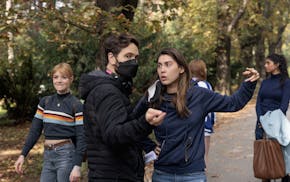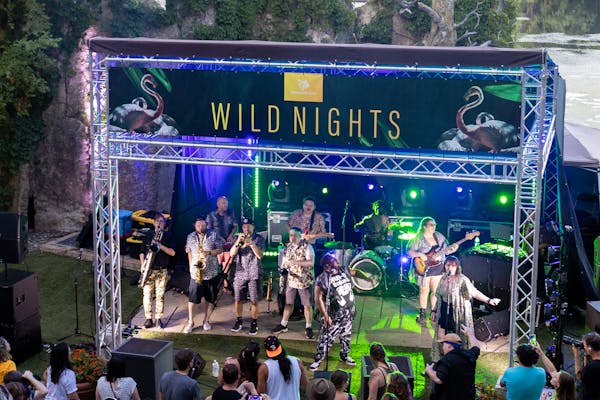Minnesota Zoo officials this week will unveil an imaginative reuse of the zoo's long-idle monorail, turning it into what they say will be the world's longest elevated walking loop to give visitors a bird's-eye view of animals and their habitats.
Officials say the $37.4 million Treetop Trail — which has its grand opening Friday — will revitalize the Apple Valley zoo, which suffered a pandemic-driven 24% decline in attendance from 2020 to 2022, when the zoo drew 985,000 visitors.
"The big shift is that we really want to be more than a zoo, we want to be a place where people are connected to nature," said Director John Frawley. "I can't wait to see thousands of people up on the trail. It's just making the zoo even better."
The 1.25-mile trail, which will be accessible via an elevator and included with admission, will enable zoogoers to stroll as high as 32 feet above the ground while viewing the zoo's woods, ponds and 10 different animal exhibits, including camels, bison and tigers. It will open to the public at 11 a.m. Friday after a ribbon-cutting ceremony.
The trail, topped with deck boards made from recycled milk jugs and lined with steel railings, varies in width from 8 to 12 feet and has four access points, along with wi-fi, a public address system and security cameras.
"You're in the canopy of the trees — that's what really struck me," said Charlene Briner, who was chair of the zoo's board of trustees while plans for the trail took shape. "You're in the world's best treehouse."
The Northern Trail habitats were designed to be seen from the monorail, Frawley said, and "to have [those views] back is going to be spectacular for guests."
The zoo's monorail, once billed as a futuristic way for families to see zoo exhibits without trekking miles on foot, shut down in 2013 after parts became scarce and ridership declined. The cars went away, but the steel beams and tracks remained.
Lee Ehmke, the Minnesota Zoo's director from 2000 to 2015, said a previous master plan called for removing the monorail, which would have cost millions.
"I think it's great that the zoo's been able to repurpose it," said Ehmke, now director of the Houston Zoo. "We're talking a lot about green building practices now, and probably the most energy-efficient building practice ... is to use something that's already been built."
High Line inspired
Frawley said that when he was hired as zoo director in 2016, the unused monorail was a conspicuous mass of metal right in the middle of the zoo grounds. "There was really no plan for it," he said.
On a trip to New York to see friends, Frawley visited the High Line — a picturesque public park built on an old elevated freight rail line in Manhattan that opened in 2009. It's 30 feet off the ground and 1.45 miles long.
"I was like, 'We should go back and see if we can do this back at the zoo with our monorail,'" he said.
Engineers told Frawley the monorail structure was well-built and strong enough to accommodate a walking track. And reusing the tracks fit well with the zoo's sustainability mission, he said: "Everybody just kind of fell in love with the concept."
The zoo began a $39 million fundraising campaign aimed at building the Treetop Trail along with renovating its family farm exhibit. The project received $11 million from the Legislature and another $26 million from donors, including Minnetrista-based KAHR Foundation, Target, the Shakopee Mdewakanton Sioux Community and Best Buy.
Jamie Flaws, the trail's project manager and now the Zoo Foundation's chief advancement and strategy officer, said there are sizable elevated walking paths in China, Singapore and Vancouver, but not as many in the United States.
The project was challenging to start with, but building the trail during the COVID-19 pandemic was particularly complex, she said. There were supply-chain issues and rising costs.
"Construction teams had to be extremely creative," Flaws said. Pieces were built off-site, brought in with cranes, then pushed onto track segments with a cart.
But zoo officials and board members persevered, Frawley said: "We just wanted to build it."
Zoo monorails
The Minnesota Zoo's monorail was introduced shortly after the zoo opened in 1978. In the following decades, monorails were a a very big deal for zoos, said Allen Nyhuis, co-author of "America's Best Zoos" in 2008. Monorails had "a Disneyesque feel ... It's modern and just kind of cool," he said.
But the Minnesota Zoo's monorail — for which visitors were charged extra — often struggled to attract riders. Some complained that the animals were too far away to see.
Then there were mishaps. In 2000, a monorail train at the zoo failed to stop and crashed into another train, injuring four people. Dozens of riders were stranded in 2011 after the monorail stopped and wouldn't start again. Firefighters had to help people climb down 18 feet to get off.
Monorails once were popular features at zoos in Dallas, San Diego, Tampa, Philadelphia, Toronto, Miami and New York. But now only the Bronx Zoo still has an operational monorail, Nyhuis said. Zoo Miami decommissioned its monorail just over a year ago, when the manufacturer went out of business and parts became harder to find.
The Dallas Zoo retired its monorail in 2020, said spokeswoman Kari Streiber. "It became a challenge operationally to maintain it," she said. The tracks are still there, she said, and the zoo is looking into what they might do with them.
Streiber said pictures of the Treetop Trail were beautiful, adding that she couldn't wait to see it.
'A gift to everybody'
Frawley said the trail is designed to be enjoyed by everyone — all communities, abilities and ages. For people who aren't ready for intense outdoor experiences, he said, it's "kind of a baby step into nature."
In planning the trail, Frawley said, feedback from various groups had a theme of keep it simple. "Don't try to make it a show or something that it's not," he said.
Jacqui Mason, a zoo donor who previewed the trail last week, called it tranquil.
"Just the serenity, I think, is what's impressing me," she said.
Trail visitors will encounter zookeepers with "ambassador animals" such as porcupines, skunks and red-tailed hawks — all Minnesota animals with a connection to trees.
But the trail will offer more than a nice stroll and nature lessons. The zoo is planning programming on its wider bump-out areas, ranging from yoga classes to musical performances.
The trail also will be used for events, including after-hours functions, said Eric Galler,the zoo board's chair. "We think that the appeal is going to be very broad," he said.
Frawley called the trail "a gift to everybody in Minnesota."
"I think a lot of people are going to benefit from this new walk in the woods," he said. "There's nothing really like it."

Chaska native's directorial debut 'Tarot' will be in 3,500 theaters

